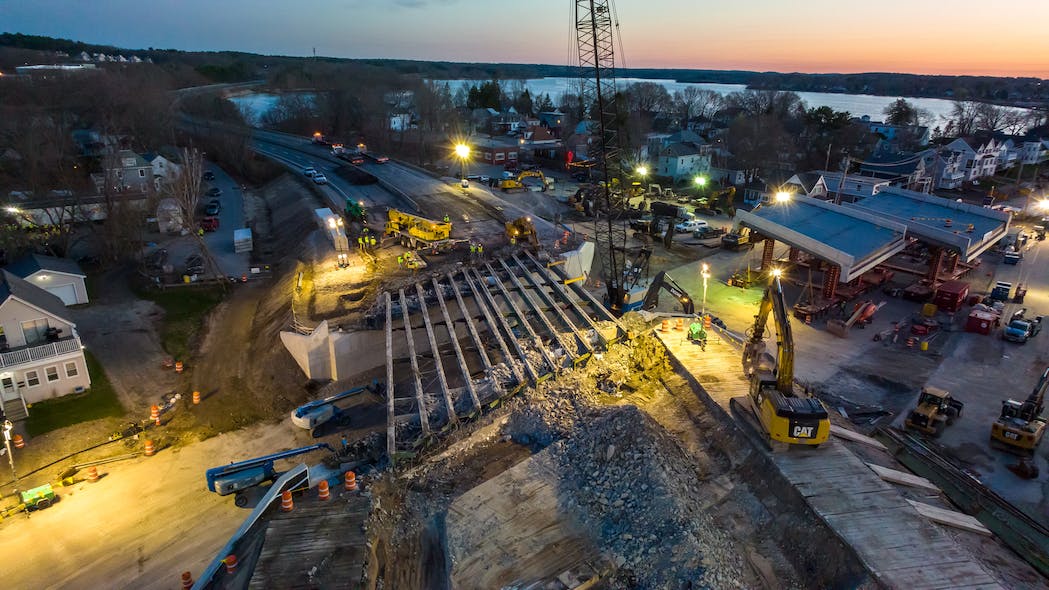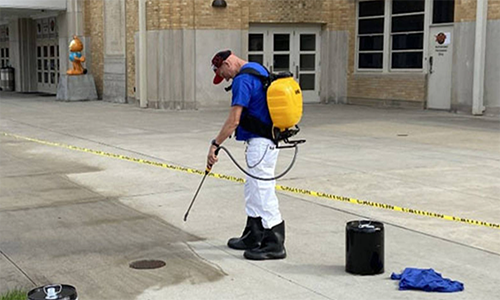By Suze Parker, Contributing Author
Editor’s Note: The Veranda Street Bridge project was named to our annual list of Top 10 Bridges for 2022, earning third place. MaineDOT’s planning and execution of this project demanded more space that we could afford in our awards issue, and so we asked the authors to expand on the story in the second installment of DOT Corner.
The story of how the Maine Department of Transportation replaced the bridge carrying I-295 over Veranda Street in Portland, Maine, is one of complex challenges converted into opportunities.
After six decades of use, the Veranda Street Bridge was due for replacement. MaineDOT, its owner, wanted to replace the old bridge with a shorter, low-maintenance structure. The project also included reconfiguring Veranda Street, a two-lane divided roadway beneath the bridge.
With interstate on- and off-ramp configurations that promoted high-speed travel and an environment unfriendly to pedestrians and bicyclists, Veranda Street was prone to frequent crashes.
Using conventional construction methods would have required a four-year endeavor that entailed building a large temporary bridge, briefly closing the I-295 northbound off-ramp and possibly demolishing nearby buildings. Daily traffic jams would have been the norm for the nearly 55,000 motorists who travel this busy stretch of I-295 each day.
Recognizing these challenges, MaineDOT worked together with HNTB to reimagine the project and leverage the strong benefits of accelerated bridge construction (ABC).
“MaineDOT prides itself on being a customer-focused agency,” said HNTB Project Manager Tim Cote. “Its leaders were concerned about the significant impacts that conventional construction would have on traffic flow and mobility. ABC balanced the project constraints and enabled swift delivery of a quality project in one of the most heavily traveled corridors in the state.”
Using ABC, MaineDOT replaced the old, three-span bridge with a new, low-maintenance single-span structure in one weekend. Work began to remove the existing structure on Friday, April 22, 2022, at 6:45 p.m. By Monday, April 25, at 6:45 a.m., the new bridge was in place, paved, striped and open to traffic.
“Drivers who had used the old bridge to get home on Friday evening were able to cross a brand-new bridge on their return to work the following Monday,” said MaineDOT Commissioner Bruce Van Note.
Achievement driven by scrupulous planning
MaineDOT previously had completed projects using ABC methodology, but the Veranda Street Bridge was among the largest and most ambitious ABC projects the agency had undertaken. The project was immensely complex, requiring more than seven years of traffic, geotechnical and structural planning, design, and coordination leading up to the final demolition of the old bridge and installation of the new span.
Although the ABC approach still required an I-295 closure, the shutdown was limited to a single weekend. This minimized impacts to the traveling public and eliminated up to four years of daily travel delays on the interstate, reducing user costs by 80% and enhancing safety for workers and motorists. Costs were comparable to conventional construction, because the premium associated with ABC was largely offset by elimination of the temporary bridge.
Removing the old Veranda Street Bridge and installing its replacement in the tight weekend window of just 60 hours – including closing I-295 and a busy stretch of Veranda Street without creating gridlock – required meticulous planning, design, and coordination.
“Essentially, the project team reverse engineered the traffic challenge, modeling traffic operations on the surrounding roadways to determine how much traffic could be added before delays became unacceptable,” Cote said. “Based on those results, MaineDOT set a goal of reducing traffic volumes by at least 25% during the closure period.”
MaineDOT led the implementation of an extensive public outreach campaign in the weeks leading up to the closure, achieving a 40% traffic reduction. This effort, and work to maximize the capacity of the local roadway network, were critical to maintaining traffic operations during the closure.
Beginning in March 2021, the contractor consolidated the Veranda Street roadway to remove its wide grass median and temporarily relocate the roadway beneath the southerly span of the existing bridge. This created needed space adjacent to the highway and allowed for the construction of the upper portions of the new bridge on temporary supports away from traffic.
New foundations were constructed under the old bridge as traffic passed overhead unimpeded. Once the new bridge foundations were mostly complete, the Veranda Street roadway was shifted into its final location beneath the north span of the existing bridge in summer 2021.
Because the new bridge would be shorter than the old structure, the remaining area below the two southerly spans of the old bridge were converted into lightweight embankments. Deposits of soft marine clay at the project site required more than 9,000 cubic yards of geofoam lightweight fill to avoid post-construction settlement.
The embankments were built primarily using 8-foot-by-4-foot-by-3-foot expanded polystyrene blocks, with lightweight cellular concrete placed atop the blocks and used to backfill the remaining, hard-to-access areas. This combination of lightweight fill allowed the embankments to be built to within inches of the underside of the existing bridge without affecting traffic and before the bridge above was demolished, saving precious time during the closure.
During the designated April 2022 weekend, the interstate was closed on Friday evening. The existing bridge was rapidly demolished, with the bridge deck and steel bridge beams removed by noon on Saturday. By the early morning hours of Sunday, the two new, 800,000-pound Veranda Street Bridge structures had been successfully lifted, moved, and set into place using self-propelled modular transporters.
Throughout Sunday, crews installed two dozen precast approach slabs, placed and compacted thousands of yards of gravel and, through the early hours of Monday, paved the roadway and installed temporary concrete barriers. I-295 reopened a full four hours early and just in time for the busy Monday morning commute.
A well-informed public embraces the project
While ABC’s ability to cut the construction period in half was good news to communities around the project site, public engagement was critical to help neighbors understand how the compressed schedule would affect them.
“Because of the high-profile, high impact nature of this project, it was especially important to get the customer service aspect right,” Van Note said. “MaineDOT emphasized open communications with both contracting partners and customers, putting tremendous effort behind marketing and advertising the public relations campaign associated with the project, which we nicknamed The Veranda Plan.”
Workshops that solicited public input started early and extended throughout construction. Through 3D still-image renderings and video animations, the project team helped nearby communities envision the project process, detour route operations and future roadway functionality. These efforts significantly elevated the level of public acceptance and buy-in, according to Devan Eaton, MaineDOT’s senior project manager.
Outreach efforts also included an aggressive, multi-media campaign to influence motorist behavior during the I-295 closure. Print, digital, TV and radio advertising advised motorists about the upcoming closure and pointed them to the project website, where they could learn more about the project, the need to avoid the work area during the closure, and available detour routes for those who had to travel.
“Our public outreach efforts leveled up on this project,” Eaton said “A benefit of the pandemic is that we have expanded our use of virtual tools to distribute information beyond the traditional face-to-face public meeting process. For all the benefits of accelerated bridge construction, we would have been highly challenged to complete a weekend closure of an interstate if we hadn’t had the ability to provide so much information so quickly to so many people.”
Recognizing the expanded reach realized by using virtual public meetings, MaineDOT held its first-ever live “virtual podium” public meeting a few weeks before the closure. Participants listened to a live stream of the meeting and submitted questions in a chat box, which the project team answered in real time.
During the weekend closure, live-streamed video gave the public a virtual front-row seat to ABC in action. Being able to see the activity, construction manpower and equipment on the project site satisfied the community’s curiosity about how a major bridge project could be accomplished in such a short period. The live stream received more than 75,000 views during the weekend closure.
Outreach so successfully involved the community that nearby residents held a block party to watch the old bridge demolition.
“Neighbors were out with their coolers, cheering together as the bridge came down,” Cote said. “The morning the project opened, news articles and social media were marveling at what an accomplishment it had been. I can’t think of another project for which the public feedback has been so universally positive.”
ABC delivers on MaineDOT’s project goals
The Veranda Street Bridge replacement supports MaineDOT’s desire for resilient and sustainable infrastructure. The new, shorter bridge has a design life of more than 100 years and will reduce future maintenance costs. Construction was completed in record time and with broad public support.
Veranda Street improvements modernize and simplify the local roadway, eliminating one of the highest crash locations in the state. The resulting roadway reconfiguration also reclaimed 1.4 acres of previously unusable space, which now serves as a community green space. New bike lanes, sidewalks and a multi-use path emphasize MaineDOT’s commitment to safely and effectively accommodating all users.
The project, completed in November 2022, demonstrates an innovative implementation of ABC that leveraged the project’s unique complexities into an opportunity, underscoring the benefits realized by thinking beyond traditional solutions.
“ABC prevented an extended interstate closure that would have caused significant disruption to the people who live and work in Portland,” Van Note said. “MaineDOT formulated a plan, communicated that plan to our customers and then did what we said we were going to do. The Veranda Street Bridge Replacement project embodies MaineDOT’s core values of integrity, competency, and service.” R&B
Suze Parker is a public relations consultant and writer who frequently writes about roads, bridges and other infrastructure projects.












